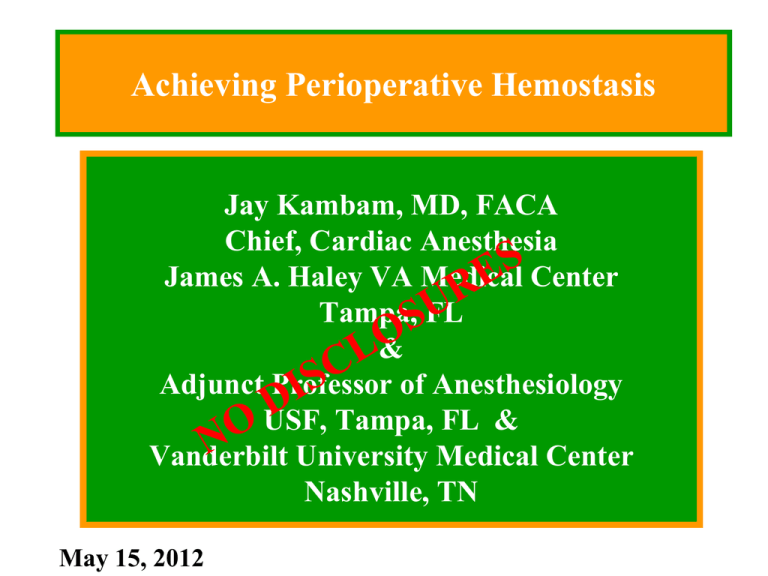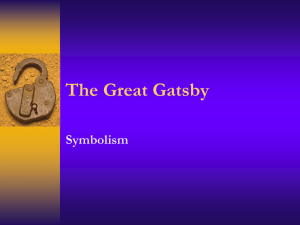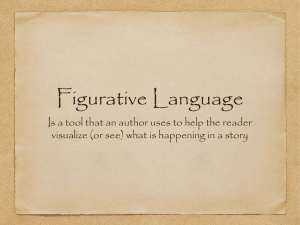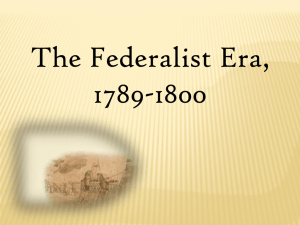Perioperative Hemostasis
advertisement

Achieving Perioperative Hemostasis Jay Kambam, MD, FACA Chief, Cardiac Anesthesia James A. Haley VA Medical Center Tampa, FL & Adjunct Professor of Anesthesiology USF, Tampa, FL & Vanderbilt University Medical Center Nashville, TN May 15, 2012 PERIOPERATIVE HEMOSTASIS • Normal hemostasis is a complex interaction between vessel wall, platelet function, plasmatic coagulation, and fibrinolysis. • Causes of perioperative coagulopathy and bleeding are multifactorial • Because of PCI and Stents, multiple antiplatelet drugs and thrombin inhibitors are increasingly being used • Understanding the details of perioperative hemostasis and pharmacodynamics of drugs involving hemostasis is essential Jay kambam • Blood must be fluid • Must coagulate (clot) at appropriate time – Rapid – Localized – Reversible (fibrinolysis) Thrombosis…inappropriate coagulation (Examples: DVT, Stent Thrombosis) Jay kambam HEMOSTASIS: 3 Major systems involved • Vessel wall Endothelin • Platelets Adhesion, Activation, Aggregation (AAA) • Coagulation cascade Coagulation factors Plasmin FSP Jay kambam Vessel Injury Collagen, vWF Endothelin Platelet-fibrin clot FSP Jay kambam VESSEL WALL - ENDOTHELIUM VESSEL WALL - ENDOTHELIUM Vessel injury or FB/Stent, low flow Antithrombogenic (Favors fluid blood) Anticoagulants Thrombogenic (Favors clotting) Procoagulants Jay kambam VESSEL WALL Endothelin, Collagen, tPAI, vWF, Factors, PL Prostacyclin, NO, ADPase, tPA, Heparin, Thrombomodulin Jay kambam Antithrombotic Properties of Endothelium Covers highly thrombogenic basement membrane Uninjured endothelium does not bind platelets PGI2 (prostacyclin) and NO from uninjured endothelium inhibit platelet binding (anti-Txa2) ADPase counters the platelet aggregating effects of ADP Jay kambam Antithrombotic Properties of the Endothelium Heparin like molecules: activate anti-thrombin III Thrombomodulin (glycoprotein) - Antithrombin – Binds to thrombin – Decreases ability to produce fibrin – Increases ability to activate Protein C, which inactivates factors Va and VIIIa Endothelial cells produce tPA which activates fibrinolysis via plasminogen to plasmin Jay kambam Prothrombotic Properties of Endothelium Synthesis of von Willebrand factor (vWF) Release of collagen & tissue factor (FIII) Production of plasminogen activator inhibitors (tPAI) Membrane phospholipids bind and facilitate activation of ++ clotting factors via Ca bridges VASOCONSTRICTION Serotonin causes vasoconstriction Jay kambam Dense Granule Alpha Granule Jay kambam Contents of platelet secretary granules and their physiological activities Secretary Granules Physiological activities Coagulation factors I & V Platelet specific proteins Platelet F4 Cofactors for coagulation cascade Low affinity PF4 Glycoproteins PF4 potentiates ADP induced aggregation & antiheparin activity LA-PF4 possesses antiheparin actvty Adhesion and cell to cell interaction ADP and ATP ADP stimulates aggregation & secretion Calcium Serotonin Promotes coagulation Vasoconstriction Jay kambam Adhesion, Activation, Aggregation (AAA) Jay kambam PLATELET FUNCTION AGGREGATION GPIIb/IIIa - fibrinogen interaction Key step for hemostasis, part of final common pathway Therapeutic target of inhibitors Jay kambam Platelet Activation Pathways Arachidonic acid TxA2 GP IIb/IIIa Fibrinogen Jay kambam Jay kambam Vessel Injury Collagen, vWF Endothelin Platelet-fibrin clot FSP Jay kambam Factor Trivial Name(s) Pathway: Intrinsic/Extrinsic I Fibrinogen Both II Prothrombin Both III Tissue Factor Extrinsic IV Calcium Both V Proaccelerin, labile factor, accelerator (Ac-) globulin Both VI (same as Va) Accelerin Both VII Proconvertin, serum prothrombin conversion accelerator (SPCA), cothromboplastin Extrinsic VIII Antihemophiliac factor A, antihemophilic globulin (AHG) Intrinsic IX Christmas Factor, antihemophilic factor B,plasma thromboplastin component (PTC) Intrinsic X Stuart-Prower Factor Both XI Plasma thromboplastin antecedent (PTA) Intrinsic XII Hageman Factor Intrinsic XIII Protransglutaminase, fibrin stabilizing factor (FSF), fibrinoligase Both Jay kambam XIIa XIa TF IIIa Prothrombin II VIII IXa VIIIa VIIa V Fibrinogen I Thrombin IIa Soft clot Fibrin XIIIa Hard clot Fibrin Jay kambam Jay kambam FINAL STEPS - COAGULATION Jay kambam Platelet-Fibrin clot Jay kambam Minimum Fibrinogen Levels Jay kambam CRYOPRECIPITATE Jay kambam Transfusion-associated Circulatory Overload (TACO) Jay kambam FIBRINOLYSIS Fibrinolysis Plasminogen tPA (Tissue Plasminogen Activator) Fibrin Plasmin Fibrin Split Products (FSP) Jay kambam FIBRINOLYSIS Jay kambam Antifibrinolytics Lysine Analog Jay kambam € Aminocaproic acid & Tranexamic acid Jay kambam (Angiomax) (Refludan), Jay kambam ANTIPLATELET DRUGS - Mechanisms Aspirin - Thromboxane A2 Inhibitors Clopidogrel (Plavix) Prasugrel (apagrel) Ticlopidine (Ticlid) Thienopyridines Aggrastat (tirofiban) ReoPro (abciximab) Integrilin (eptifibatide) GP IIb/IIIa Antagonists P2Y12/ADP Receptor Inhibitors Jay kambam Antiplatelet Drugs: Inhibition of activation &/or aggregation Jay kambam Jay kambam ASPIRIN • • • • • • Inhibition of Thromboxane A2 production Orally administered Rapidly absorbed from GIT Peak levels observed in about 30 minutes Irreversible COX type 1 inhibitor Chew and do! Jay kambam TICLOPIDINE, CLOPIDOGREL & PRASUGREL • Antiplatelet agents are used to treat, prevent arterial thrombosis. • Thienopyridine derivatives, inactive in vitro, requiring metabolism to achieve in vivo activity. • Inhibit binding of ADP to platelet receptor(P2Y12). Jay kambam CLOPIDOGREL Prodrug (Thienopyridine) Administered only orally No direct antiplatelet activity Metabolized in the liver Active metabolite inhibits platelet aggregation Peak concentration of active metabolite is seen in 1 -2 hrs Metabolite binds to platelet P2Y12 receptor and irreversibly inhibits ADP-induced platelet aggregation Jay kambam PRASUGREL Prodrug (Thienopyridine) Ten to 100 times more potent than clopidogrel Administered only orally No direct antiplatelet activity Metabolized in the liver more rapidly (levels 2 times higher) Faster activity Active metabolite inhibits platelet aggregation Peak concentration of active metabolite is seen in 0.5 hr Metabolite binds to platelet P2Y12 receptor and irreversibly inhibits ADP-induced platelet aggregation Jay kambam PLATELET INHIBITORS Aspirin - Thromboxane A2 Inhibitors Clopidogrel (Plavix) Prasugrel (apagrel) Ticlopidine (Ticlid) Thienopyridines Aggrastat (tirofiban) ReoPro (abciximab) Integrilin (eptifibatide) GP IIb/IIIa Antagonists P2Y12/ADP Receptor Inhibitors Jay kambam Gp IIb/IIIa ANTAGONISTS • Platelet Gp IIb/IIIa receptors play a pivotal role in platelet-mediated thrombus formation, binding to fibrinogen,vWF & Collagen • IIb/IIIa antagonists differ in receptor affinity, reversibility, and specificity • GpIIb/GpIIIa antagonists more completely inhibit platelet aggregation than do ASA and Theinopyridines Jay kambam Jay kambam Platelet Activation Pathways Arachidonic acid TxA2 GP IIb/IIIa Fibrinogen Jay kambam GP IIb/IIIa Antagonists: Tirofiban (Aggrastat) Eptifibatide (Integrelin) Abciximab (ReoPro) GP IIb/IIIa antagonist Inhibition of platelet aggregation GP IIb/IIIa receptors occupied by antagonists Agonist ADP, thrombin, collagen, epi Inactive platelet GP IIb/IIIa Active Platelet receptors in unreceptive state Aggregating platelets Jay kambam Glycoprotein IIb/IIIa inhibitors Tirofiban (Aggrastat) • Nonpeptide • KD 15 nmol/L • Indication: acute coronary syndrome Jay kambam Glycoprotein IIb/IIIa inhibitors Eptifibatide (Integrelin) • Cyclic peptide • KD 120 nmol/L • Acute coronary syndrome Jay kambam Glycoprotein IIb/IIIa inhibitors Abciximab (ReoPro) • Human/murine chimeric monoclonal antibody Fab • KD 5 nmol/L • Indication: PCI Jay kambam Anticoagulant and Antiplatelet Drugs • Platelets Primary Hemostasis Plug Antiplatelet Drugs: TxA2 Inhibitors: ASA Thienopyridines: Clopidogrel, Prasugrel, Ticlopidine; GP IIb/IIIa Antagonists: Tirofiban (Aggrastat), Eptifbatide (Integrelin), Abciximab (ReoPro) Jay kambam Anticoagulants: Direct & indirect antithrombin drugs Jay kambam ANTICOAGULANTS Indirect Thrombin Inhibitor Drugs: • Vitamin K antagonists, Coumadin (in vivo only) • Ca++ chelators (in vitro only) – EDTA, Citrate, Oxalate • Heparin (in vivo and in vitro) Direct Thrombin Inhibitor Drugs: Bivalirudin (Refludan), Lepirudin (Angiomax), Argatroban (Acova) Dabigatran (Pradaxa)* Jay kambam Role of vitamin K Some clotting factors require a post-translational modification (PTM) before they are active in clotting These factors are II, VII, IX, X This PTM involves the addition of a COO- to certain Glu residues in the clotting factors This PTM results in the formation of several g-carboxy glutamates = Gla This PTM requires vitamin K Jay kambam HEPARIN - SOURCES • • • • • Lungs Liver Intestinal mucosa Mast cells of RES Bovine and Porcine Jay kambam HEPARIN - STRUCTURE One of the strongest acids Heavily sulfated polyanionic mucopolysaccharide Mol Wt: 6000-25000 Daltons Similar to nucleic acids (Phosphates) Jay kambam HEPARIN - PROPERTIES Action begins immediately Peaks in 2 - 5 min Distribution volume - small (plasma, RES)** Dose: Adult 3-4mg/kg; Child: 1-3mg/kg Duration of action - 60-90 min in normothermic bypass; prolonged with hypothermia Acute Side effects: vasodilatation ** ideal body weight Jay kambam HEPARIN - MECHANISM OF ACTION Jay kambam HEPARIN RESISTANCE Possible causes: • • • • • • • • • a . ATIII deficiency (congenital or acquired) b. Arteriosclerotic disease c. Septicemia d. Pregnancy e. Birth control pills f. Liver disease g. Prolonged anticoagulant therapy h.Thrombocytosis i. Nephrotic Syndrome Jay kambam HEPARIN RESISTANCE • Since the likely cause is ATIII deficiency: the treatment options are: – Give ATIII 50 units /kg – and or 2-4 units of FFP Jay kambam Heparin Induced Thrombocytopenia (HIT Syndrome) Immune-mediated allergic reaction to heparin/platelet factor 4 complex Thrombocytopenia: Platelet count <150,000 or a 30% to 50% drop from baseline during heparin exposure Onset 5 to 14 days after initiating heparin but can be earlier or later With or without thrombotic complications at presentation Diagnosis is clinical Any type of heparin or route of administration can lead to HIT Jay kambam Temporal Patterns of Thrombocytopenia in HIT Heparin (re) Exposure Rapid-onset HIT (hours-days) Day 1 Typical-Onset HIT Mean day 9 (5-14 days) Day 5 DelayedOnset HIT (9-40+ days) Day 14 Day 30 THROMBOCYTOPENIA (± THROMBOSIS) Jay kambam HIT occurs in up to 5% of patients receiving unfractionated heparin (UFH) Up to 1% incidence with low molecular weight heparin (LMWH) Mortality rate of 22% to 28% has been reported in patients with HIT associated with thrombosis not treated with alternative anticoagulation. Jay kambam HEPARIN ALTERNATIVES Direct Thrombin Inhibitors • • • • Bivalirudin (Refludan) Lepirudin (Angiomax) Argatroban (Acova) The best choice depends on patient’s health status (hepatic or renal function) • Dabigatran (Pradaxa)* Jay kambam Diagnosis and Management Decisions for HIT • Current or recent heparin exposure with thrombocytopenia • Presence of thrombosis or other characteristic sequelae • If HIT is suspected, discontinue all forms of heparin IMMEDIATELY: Initiate alternative anticoagulant, as indicated Jay kambam Dabigatran (Pradaxa) Direct thrombin inhibitor-oral anticoagulant, Half Life: 13-27hrs, Does not require frequent blood tests for International normalized Ratio (INR) monitoring Not highly protein bound, excreted 80% via kidneys & 20% via bile, partially through hemodialysis There is no specific way to reverse the anticoagulant effect of dabigatran in the event of a major bleeding event, unlike warfarin. Dosage upto 150 mg twice daily? The (FDA) approved Pradaxa on October 19, 2010, for prevention of stroke in patients with non-valvular atrial fibrillation On February 14, 2011, the ACC & AHA added dabigatran to their guidelines for managment of non-valvular atrial fibrillation with a class I recommendation aPTT (activated partial thromboplastin time), ECT (Ecarin clotting time), TT (Thrombin time) Jay kambam Dabigatran Discontinuation before surgery Jay kambam Vessel Injury Collagen, vWF Endothelin Platelet-fibrin clot FSP Jay kambam (Angiomax) (Refludan), Jay kambam Perioperative Hemostasis Optimize coagulation & reduce fibrinolysis Normal hemostasis is a complex interaction between vessel wall, platelet function, plasmatic coagulation, and fibrinolysis. Causes of perioperative coagulopathy and bleeding are multifactorial – Not addressed in this lecture Fibrinogen is in the key position of coagulation cascade and fibrinolytic pathway. Understanding the process of perioperative hemostasis and pharmacodynamics of drugs involving hemostasis is essential Jay kambam Stupid Monkey drinking my coffee @Kilimanjaro, Kenya HISTORICAL ACHIEVEMENTS DATE ACHIEVEMENT Miescher - 1868 Kossel - 1896 McClean - 1916 Hagedorn - 1930’s Jaques, McCutcheon - 1930’s Chargoff, Olson - 1937-38 Walther - 1939 Jaques - 1949 Hersley - 1966 Jaques - 1973 Discovered protamine in salmon gonads Isolated protamines from various kinds of fish Discovered heparin’s anticoagualtion action Made long-acting insulin with protamine Produced heparin-protamine complex Discovered heparin’s antidote Reported protamine’s adverese effects Poineered study of protamine’s toxic effects Developed ACT test Developed hep-prot titration test 2. Changes Affecting Platelet Aggregation: a) Decreased ability of Platelet Aggregation to Agonists b) Platelets are Activated by CPB (2030% Spent) c) Platelets bind to Monocytes and Neutrophils 3. Changes Affecting Clot resistance to Clot lysis by Plasmin: Preactivation of Platelets Leads to Depletion of Plasmin Inhibitors (stored in platelets) which are Critical to protecting the clot from lysis by the Plasmin TICOLPIDINE/CLOPIDOGREL In CAD stenting, ticlopidine reduces risk for subacute stent thrombosis Clopidogrel reduces ischemic events with recent MI, stroke, or PVD Clopidogrel + aspirin in stenting, is rapidly growing, given before stenting procedure Bleeding variability for cardiac surgery relates to the duration of therapy Heparin Manufacturing Process • Combine 5000 lbs intestines, 200 gallons water, 10 gallons chloroform, and 5 gallons toluene. Hold at 900 F for 17 hrs. • Add 30 gallons acetic acid, 35 gallons ammonia, sodium hydroxide to adjust pH, and 235 gallons water. Bring to a boil then filter. • Add 200 gallons hot water to filtrate and allow to stand overnight, then skim off the fat. • Keep pancreatic extract at 1000F for three days, then bring to boil. • Filter solids and assay for heparin content. Heparin source comparison BOVINE LUNG Cost Less Mol Wt (Daltons) 5000-20,000 Chemical structure Shorter chains Platelet aggregation ++ Thrombin inhibition Less Factor aX inhibition More Post op bleeding More Protamine requirement Less Delayed thrombocytopenia ++ PORCINE MUCOSAL More 6000-30,000 Longer chains + More Less Less More + Bivalirudin (Refludan) • • • • • Half Life 25 min Reversal: None Metabolism: Renal > Hepatic Monitoring ACT, ECT (Ecarin Clotting Time ) Dosage 1.5 mg/kg bolus, then continuous infusion at 2.5 mg/kg /h • Other: Titrate ACT > 500 Lepirudin (Angiomax) • • • • • • Half life: 30 min Reversal: None Metabolism: Hepatic > Renal Monitoring PTT, ACT Dosage 0.1 mg /kg bolus then 5-10 ug/kg/min Other: Incidence of Hypercoagulable state after DC the continuous infusion Argatroban (Acova) • • • • • • Half life 80 min Reversal: None Metabolism: Renal Monitoring PTT, ECT (Ecarin Clotting Time) Dosage 0.25 mg/kg , then 0.5 mg /min infusion Other: Increase incidence of post-op bleeding. Incidence of anaphylaxis with the second exposure





